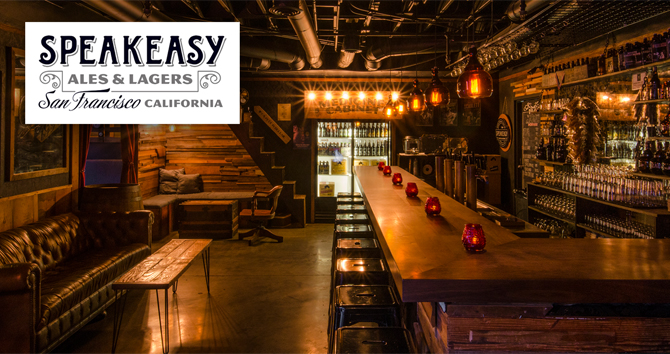Seven months after purchasing Speakeasy Ales & Lagers out of receivership, new owner Cestra “Ces” Butner has reconstructed the company’s California distribution network and reopened the San Francisco brewery’s taproom.
Butner, the former owner of the Horizon Beverage distributorship in Oakland, acquired the troubled Speakeasy brand in May — two months after the company ceased brewing operations and closed its taproom.
In a conversation with Brewbound, Butner said he saw potential in the Speakeasy brand, which Horizon had distributed for five years. In fact, he recalled building Speakeasy’s on-premise business in the East Bay from 11 tap handles to about 1,100.
“I did very well with the brand, so I’m very familiar with it,” he said. “We believed in the brand — that’s the first thing that you’ve got to do is have a wholesaler who believes in the brand. And we think with our relationships with the wholesalers that we’ll bring it back.”
The company has some ambitious plans for 2018.
Speakeasy vice president and general manager Sam Cappione told Brewbound that the company is forecasting sales of 22,000 barrels of beer after producing about 10,000 barrels over five months this year.
“We’ve got an aggressive sales goal next year,” Cappione said.
Butner said it took about six months to re-establish Speakeasy’s California wholesaler network, but now the the company has built a network of about 23 distributors — many in the Anheuser-Busch network — in all but Ventura and Santa Barbara counties.
According to Butner, one of the biggest challenges in resurrecting Speakeasy was rebuilding relationships with the company’s former wholesale partners, many of whom complained that the previous owner couldn’t keep them supplied with beer.
“We had to shore all of that up and assure those people that we were going to be able to do everything we said we was going to do,” he said.
Cappione told Brewbound that the company gave its previous distribution partners “first right of refusal” to carry its beer, and about 80 percent of those wholesalers agreed to resume carrying the brand.
Still, there’s a lot of work to do. According to Butner, the brand “dried up” in the marketplace after it went into receivership in March, and Speakeasy’s San Francisco facility remained dormant until July.
“It’s kind of like re-introducing yourself into the market,” he said.

Going into receivership and dealing with out-of-stock issues also led to issues in Speakeasy’s home market of San Francisco, which accounted for about 35 percent of the company’s business prior to the sale. According to Butner, sales in every market but San Francisco in the last three months have outperformed the previous year.
“It was such a big part of their overall business, it takes a longer time to get all of that back,” he explained. “And we’re not in the chains.”
Butner said his main focus now is to restore Speakeasy’s chain grocery business, and get the brand placed into major venues throughout the Bay Area, including Levi’s Stadium, Oracle Arena and AT&T Park, where he hopes the brand will be available during San Francisco Giants games.
“Knock on wood, we will hopefully get back into Safeway in spring sets as well too,” Butner said.
According to Cappione, Speakeasy is also eyeing placements in Ralphs, Save Mart and Vons stores. He added that Speakeasy has reclaimed about 70 percent of the accounts that the brand previously held and already secured shelf space in Total Wine & More, BevMo!, Target and Whole Foods stores in California.
Additionally, Cappione said he and Speakeasy’s seven sales reps have been working to re-establish the company’s draft business, which once accounted for 60 percent of total sales.
“That’s going to be a challenge,” he said. “The only way to do that is feet on the street. I’ve got my sales force up and running for California north and south and feel like I’ve got the right people calling the distributors and working the streets with the distributors.”
Speakeasy has also maintained its East Coast distribution in New York, New Jersey, Connecticut and Massachusetts through a contract brewing arrangement with Shmaltz Brewing in Clifton Park, New York. To bolster sales in those states, Cappione said the company has hired an East Coast sales manager.
“We had no one out there moving the product,” he said. “Speakeasy had lost a lot of business prior to the sale.”

Although Speakeasy plans to continue its contract arrangement with Shmaltz, it will stop shipping bottles from the New York production facility for distribution in California once a bottling line is installed at its San Francisco brewery in January.
Producing bottles locally is an important step for the brand, Butner said. So is filling some of his 60,000-barrel production facility’s excess capacity.
At its peak, Speakeasy sold an estimated 32,673 barrels of beer, according to the Brewers Association. In order to fill those tanks, Speakeasy is opening its facility to other Bay Area brewers for contract brewing.
“Our goal is to about 10,000 or 12,000 barrels,” Cappione said. “The deal would be, we brew it, package it and they would need to pick it up within 24 hours.”
Butner said he’s in talks with a few yet-to-be-named Bay Area breweries and finalizing agreements for a few others.
Meanwhile, Speakeasy reopened its taproom last weekend after a nine-month hiatus. An official grand opening has been set for January 27.
“It kind of signals to the community that we’re back, so to speak,” Butner said. “It used to be a big part of what Speakeasy was all about — the culture of the brewery and in the Hunters Point community. We just wanted to make sure that we didn’t let that die too.”

